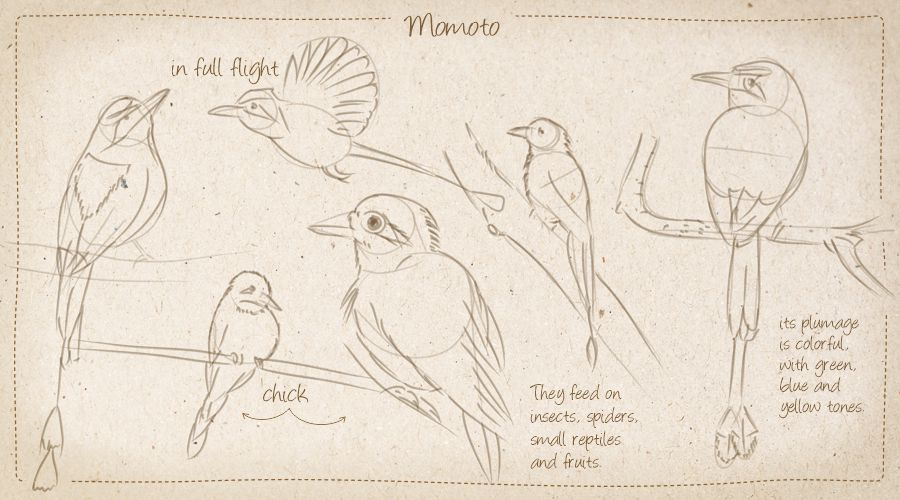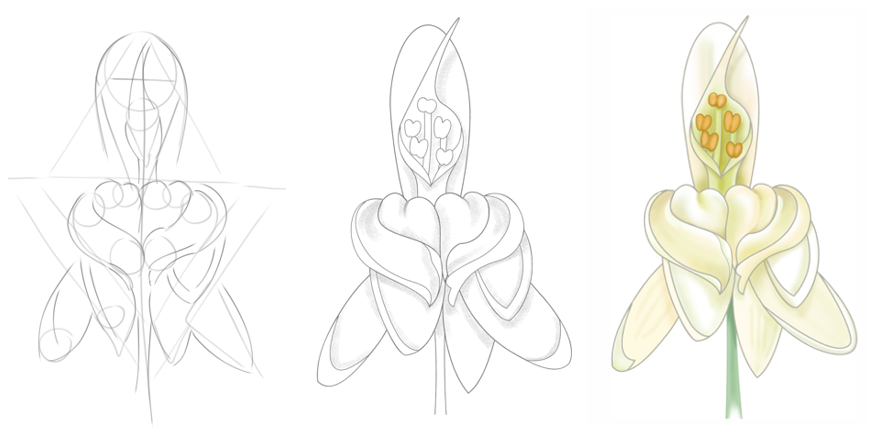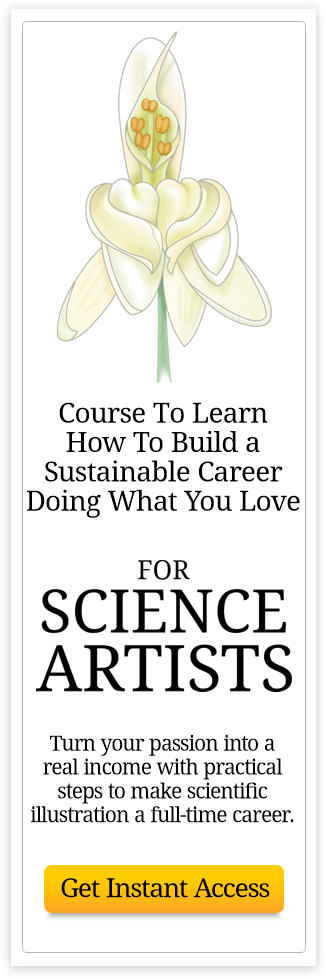
Letting Go of Perfection – The Heart of Scientific Sketching
Introduction: Why We Need to Talk About Perfection in Sketching
In scientific illustration, precision is more than a preference—it’s part of our purpose. We draw to communicate truthfully, to honor detail, and to reflect the structure of the natural world with clarity and care.
And yet, in the quiet corners of our sketchbooks—or even before pencil touches paper—many of us carry a familiar weight: the pressure to be perfect.
It doesn’t matter whether you’re just starting out or have years of experience under your belt—this feeling can find its way into any phase of our creative journey.
Beginners often worry their sketches aren’t “good enough,” while seasoned illustrators may feel an unspoken expectation to always produce work that meets professional standards, even in their rough drafts.
But what if we shifted the way we see sketching?
What if, instead of striving to get everything right, we approached sketching as a gentle, open space for thinking, observing, and understanding? A place where the goal isn’t perfection—but presence.
In this article, we’ll explore how letting go of perfection can actually make us better observers, clearer thinkers, and more confident illustrators. Whether you’re just starting out or refining your craft, this mindset might be the most powerful tool you bring to the page.
Sketching is Not the Final Word—It's the First Conversation
When we think of sketching as something we need to “get right,” it becomes a test. But sketching was never meant to be a performance—it’s a process. It’s how we begin a conversation with our subject, where observation leads and curiosity answers.
Sketching invites us to slow down, to look again, to notice the curve of a stem or the shift in a joint. It’s where we test proportions, question structure, and follow hunches. These aren’t mistakes—they’re signs that we’re paying attention.
Like jotting notes before writing a polished paragraph, sketching gives us room to think through the visual story we’re trying to tell. In that way, it’s more like a dialogue between the eye, the hand, and the mind. Every line is a sentence in that dialogue—some clear, some uncertain, some crossed out and redrawn. All of them are part of the process of learning.
When we reframe sketching as a kind of thinking-on-paper, we give ourselves permission to let go of perfection and embrace something much more valuable: understanding.
The Science Behind Sketching and Mistakes
There’s something quietly powerful about making a mark on paper, especially when we know it might not be “correct.” It turns out, the act of drawing—even imperfectly—is one of the most effective ways our brains learn.
Studies in neuroscience and education have shown that sketching activates multiple areas of the brain at once: visual processing, fine motor control, memory recall, and conceptual understanding. This multi-sensory engagement means that even rough, hesitant sketches help us see better, understand deeper, and remember longer.
In scientific illustration, where accuracy matters, it’s easy to assume that only the final, flawless image has value. But in truth, every imperfect sketch is a stepping stone toward visual clarity.
The lines we erase, the proportions we redraw, the angles we revisit—they’re not failures. They’re signals that we’re refining our perception and improving our grasp of structure, anatomy, and function.
Sketching, then, is less about producing a polished result and more about training our eyes to notice what others might overlook. The imperfections aren’t distractions; they’re evidence of inquiry. They show that we are willing to stay with a question long enough to truly understand it.
When we allow ourselves to sketch freely—without the fear of getting it wrong—we create a space where both our skills and our scientific insight can quietly flourish.

For Beginners: Sketching Without Pressure Builds Confidence
Starting out as a scientific illustrator can feel overwhelming. There’s a lot to learn—anatomy, accuracy, composition, scientific communication—and it’s easy to believe that your sketches should already look “professional” from the beginning.
But here’s the truth: every great illustrator started exactly where you are—with uncertain lines, awkward proportions, and a sketchbook full of doubts.
Perfectionism often sneaks in early, whispering that unless a drawing is precise, it’s not worth making. But the opposite is true: your early sketches are the most worth making, because they’re the foundation of everything to come. They’re where your eyes begin to train, your hand starts to trust itself, and your curiosity has space to stretch and grow.
One of the most powerful things you can do as a beginner is give yourself permission to sketch badly. To draw often, without judgment. To fill pages with explorations, quick studies, notes in the margins, and little moments of “aha!”
Your sketchbook doesn’t need to be beautiful—it needs to be yours.
Try setting aside a few minutes each day for sketching without expectations. Use loose paper if blank books feel intimidating. Practice warm-up exercises like blind contour drawing, or draw an object in 60 seconds just to capture its essence. These gentle rituals train your observational skills far more effectively than waiting for the “perfect” drawing to arrive.
Over time, you’ll start to see a quiet shift: not just in your sketches, but in your confidence. You’ll begin to feel that your lines belong, even when they’re uncertain. That your way of seeing has value, even when it’s still forming. And that’s when the magic really begins.
For Advanced Illustrators: Detachment Sparks Discovery
When you’ve been illustrating for a long time, your skillset becomes a trusted companion—your lines grow surer, your techniques more refined, your process more efficient. But with mastery can come a quiet pressure: to always produce, to always perform, to always “get it right.”
For experienced illustrators, detachment from perfection isn’t about lowering your standards—it’s about expanding your creative freedom. Letting go of the need to sketch “well” opens the door to something even more powerful: discovery.
Without the burden of polish, sketching becomes a space to ask questions again. To experiment with unfamiliar structures, test alternative compositions, or even just explore a subject you haven’t drawn in years. These sketches may never be seen by a client or published in a journal—but they are deeply valuable. They nourish your practice from the inside out.
Sometimes, detachment also means challenging your own habits. You might try drawing with your non-dominant hand, or setting aside your usual precision tools in favor of something looser and messier. You may find yourself remembering why you fell in love with this work in the first place: not because you were perfect at it, but because you were curious.
In that sense, detachment isn’t a step backward—it’s a return to your creative roots. It reconnects you to the joy of learning, the spark of problem-solving, and the boldness of play. And it’s from that place—not perfection—that some of your most original ideas may quietly begin to grow.
Gentle Practices to Embrace Imperfection in Sketching
Letting go of perfection doesn’t happen all at once—it’s something we return to, again and again, with compassion. These small, mindful practices can help reframe your sketching time as a safe space for learning, play, and quiet exploration.
🌿 1. Set a timer for 5 minutes.
Pick a natural object—a shell, a leaf, a bone—and sketch it quickly without stopping to correct. Let speed override precision. The goal is to see and feel, not to finish.
✏️ 2. Use a pen instead of a pencil.
Drawing in ink removes the option to erase, which can feel scary at first—but freeing once you get going. It reminds you that each line is a decision, not a mistake.
📄 3. Sketch on scrap paper.
Old receipts, envelopes, or the back of a printed page help shift your mindset from “precious drawing” to “just practicing.” This can lower the stakes and open the door to experimentation.
👀 4. Try blind contour drawing.
Without looking at your paper, draw the edges of your subject in one slow, continuous line. These exercises improve your observation skills and help you trust your hand’s connection to your eye.
🌀 5. Keep a “messy sketchbook.”
Reserve one notebook just for process—no pressure, no polish. Let it be your visual playground, a place where your thoughts, questions, and wonky sketches can live without judgment.
🧡 6. End each session with a kind note.
Write a short reflection at the bottom of the page: “I learned something today.” “This shape was harder than I expected.” “I'm proud I made time to draw.” These affirmations help reframe progress, not perfection, as the goal.
Each of these gentle practices is a way to remind yourself: your value as an illustrator does not rest in flawless drawings. It lives in your persistence, your curiosity, and your care.
Conclusion: The Real Goal is Growth, Not Perfection
At the heart of scientific illustration is a quiet devotion—to truth, to beauty, to understanding. But none of that begins with perfection. It begins with a question, a line, a pause. It begins with a sketch.
No matter where you are in your journey—as a wide-eyed beginner or a seasoned illustrator with years of experience—there’s something incredibly brave about showing up to the page. Not to perform, but to explore. Not to impress, but to learn.
Every polished plate, every intricate figure, every finished piece that someone admires… it all began with a page full of questions. Sketches crossed out, proportions reworked, ideas reimagined. That messy beginning is not something to hide—it’s something to honor. It’s where the real work happens.
So let this be your reminder:
You are allowed to sketch imperfectly.
You are allowed to make mistakes.
You are allowed to learn as you go.
And in doing so, you are growing—not just as an illustrator, but as someone who observes the world with deep attention and care.
Sketch freely. Sketch often. Sketch without judgment.
The lines don’t have to be perfect. They just have to be yours.
Thanks for Reading
If this article resonated with you, I hope you’ll carry its message into your next sketching session—with softness, curiosity, and a little more freedom to explore without pressure.
Whether you’re just beginning or years into your journey, your progress matters more than perfection ever could. And every line you draw—uncertain, exploratory, expressive—is a step toward deeper understanding and greater skill.
If you know someone who struggles with perfectionism in their own creative practice, consider passing this along as a gentle reminder: it’s okay to let go.
Let’s keep sketching, learning, and growing—together.
LIKE THIS ARTICLE?
YOU'LL 🧡 THE NEWSLETTER!
Get timely tips to improve your services, land more projects, illustration tips, and more...

